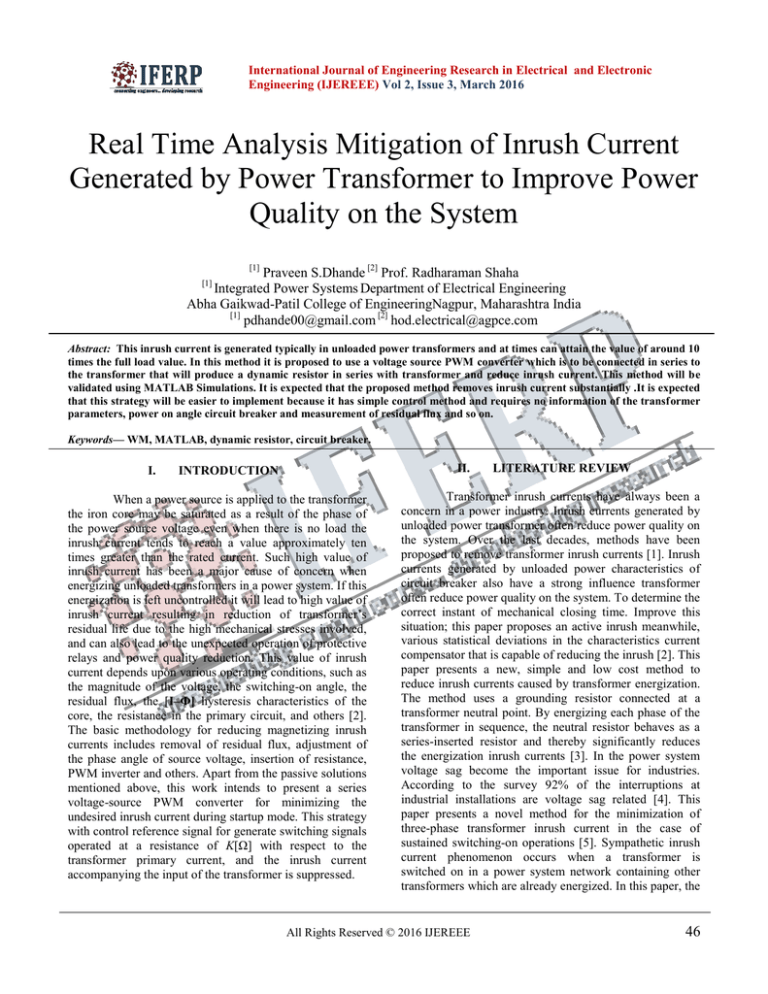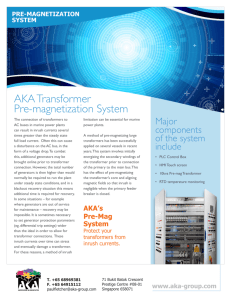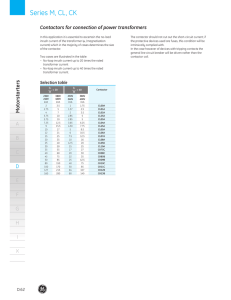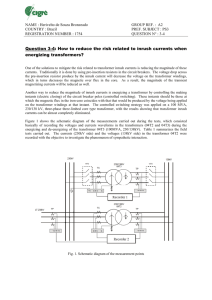
International Journal of Engineering Research in Electrical and Electronic
Engineering (IJEREEE) Vol 2, Issue 3, March 2016
Real Time Analysis Mitigation of Inrush Current
Generated by Power Transformer to Improve Power
Quality on the System
[1]
Praveen S.Dhande [2] Prof. Radharaman Shaha
[1]
Integrated Power Systems Department of Electrical Engineering
Abha Gaikwad-Patil College of EngineeringNagpur, Maharashtra India
[1]
pdhande00@gmail.com [2] hod.electrical@agpce.com
Abstract: This inrush current is generated typically in unloaded power transformers and at times can attain the value of around 10
times the full load value. In this method it is proposed to use a voltage source PWM converter which is to be connected in series to
the transformer that will produce a dynamic resistor in series with transformer and reduce inrush current. This method will be
validated using MATLAB Simulations. It is expected that the proposed method removes inrush current substantially .It is expected
that this strategy will be easier to implement because it has simple control method and requires no information of the transformer
parameters, power on angle circuit breaker and measurement of residual flux and so on.
Keywords— WM, MATLAB, dynamic resistor, circuit breaker.
I.
II.
INTRODUCTION
When a power source is applied to the transformer
the iron core may be saturated as a result of the phase of
the power source voltage even when there is no load the
inrush current tends to reach a value approximately ten
times greater than the rated current. Such high value of
inrush current has been a major cause of concern when
energizing unloaded transformers in a power system. If this
energization is left uncontrolled it will lead to high value of
inrush current resulting in reduction of transformer’s
residual life due to the high mechanical stresses involved,
and can also lead to the unexpected operation of protective
relays and power quality reduction. This value of inrush
current depends upon various operating conditions, such as
the magnitude of the voltage, the switching-on angle, the
residual flux, the [I–Ф] hysteresis characteristics of the
core, the resistance in the primary circuit, and others [2].
The basic methodology for reducing magnetizing inrush
currents includes removal of residual flux, adjustment of
the phase angle of source voltage, insertion of resistance,
PWM inverter and others. Apart from the passive solutions
mentioned above, this work intends to present a series
voltage-source PWM converter for minimizing the
undesired inrush current during startup mode. This strategy
with control reference signal for generate switching signals
operated at a resistance of K[Ω] with respect to the
transformer primary current, and the inrush current
accompanying the input of the transformer is suppressed.
LITERATURE REVIEW
Transformer inrush currents have always been a
concern in a power industry. Inrush currents generated by
unloaded power transformer often reduce power quality on
the system. Over the last decades, methods have been
proposed to remove transformer inrush currents [1]. Inrush
currents generated by unloaded power characteristics of
circuit breaker also have a strong influence transformer
often reduce power quality on the system. To determine the
correct instant of mechanical closing time. Improve this
situation; this paper proposes an active inrush meanwhile,
various statistical deviations in the characteristics current
compensator that is capable of reducing the inrush [2]. This
paper presents a new, simple and low cost method to
reduce inrush currents caused by transformer energization.
The method uses a grounding resistor connected at a
transformer neutral point. By energizing each phase of the
transformer in sequence, the neutral resistor behaves as a
series-inserted resistor and thereby significantly reduces
the energization inrush currents [3]. In the power system
voltage sag become the important issue for industries.
According to the survey 92% of the interruptions at
industrial installations are voltage sag related [4]. This
paper presents a novel method for the minimization of
three-phase transformer inrush current in the case of
sustained switching-on operations [5]. Sympathetic inrush
current phenomenon occurs when a transformer is
switched on in a power system network containing other
transformers which are already energized. In this paper, the
All Rights Reserved © 2016 IJEREEE
46
International Journal of Engineering Research in Electrical and Electronic
Engineering (IJEREEE) Vol 2, Issue 3, March 2016
phenomenon of sympathetic inrush current is investigated
using nonlinear transient field-circuit coupled finite
element formulation [6]. Digital techniques for modeling
the inrush current associated with the energization of
single-phase transformers are described. [7]. It was found
that a neutral resistor together with `simultaneous'
switching didn't have any effect on either the magnitudes
or the time constant of inrush currents [8]. With more and
more renewable and other distributed energy resources
(DERs) being adopted, the utility requires these DERs
systems have low voltage ride-through (LVRT) capability,
which means the DERs [9]. A methodology for the
reduction of the residual flux in network transformers is
proposed in this paper. The purpose is the mitigation of
large inrush currents taken by numerous transformers when
a long feeder is energized. Time-domain simulations are
used to prove that a small-power device can substantially
reduce the residual flux of all transformers simultaneously
[10].
III.
V.
DIFFERENTMETHODS
There are many possible mitigation methods which are
discussed below are different circuits which are effective in
certain operating conditions.
A. NTC Power Thermistor
One of the most common methods used to
suppress inrush current is to connect NTC (Negative
Temperature Coefficient) power thermistors in series to the
line. The resistance of a thermistor varies inversely with
temperature and offers variable resistance. One of the main
problems with this method is that the thermistor requires a
cool down-time to increase its resistance before it can take
the next impulse of inrush current. If the system were
turned OFF and ON repeatedly in a short amount of time,
the thermistors would not have sufficient time to recover in
order to limit the current again [1]. Fig. 1 shows
effectiveness of NTC to reduce heavy inrush current.
MOTIVATION
When a power source is applied to the transformer the
iron core may be saturated as a result of the phase of the
power source voltage even when there is no load the inrush
current tends to reach a value approximately ten times
greater than the rated current. Such high value of inrush
current has been a major cause of concern when energizing
unloaded transformers in a power system. Any effort in the
direction of reducing the inrush current will improve the
power quality of the system.
IV.
PROBLEM DEFINITION
Transformer inrush currents have always been a
concern in a power industry. When a power source is
applied to the transformer the iron core may be saturated as
a result of the phase of the power source voltage even
when there is no load the inrush current tends to reach a
value approximately ten times greater than the rated
current. Such high value of inrush current has been a major
cause of concern when energizing unloaded transformers
in a power system. If this energization is left uncontrolled
it will lead to high value of inrush current resulting in
reduction of transformer’s residual life due to the high
mechanical stresses involved, and can also lead to the
unexpected operation of protective relays and power
quality reduction. Over the last decades, methods have
been proposed to remove transformer inrush currents.
The problem of Inrush current and its effect on the power
quality of the system is to be mitigated.
Fig.1. Effect of NTC on inrush current
B. Current limiting impedance
Current limiting impedance can also be used to
limit inrush current of transformer. In fig. 2 current
limiting impedance is shown that would be bypassed by a
short circuit after some time has passed in order to limit the
current at the start, but still conserve power in steady state.
This impedance could be a resistor, an inductance, or a
series combination of both. The drawback of current
limiting impedance is power losses that result from steady
state current flowing through them. However, these
impedances are commonly bypassed by shortcircuiting
them to suppress such losses [2].
All Rights Reserved © 2016 IJEREEE
47
International Journal of Engineering Research in Electrical and Electronic
Engineering (IJEREEE) Vol 2, Issue 3, March 2016
Fig.2. Current limiting impedance on power transformer
The response time of current limiter is decided by
its time constant. There has to be optimized value for such
circuits which cannot be generalized. When heavy inrush
current start flowing through operating transformer, limiter
damps its magnitude. It has coupled in such a way which
demagnetizes to avoid saturation current.
C. Synchronous Closing
Each winding of the transformer should be
switched at the maximum of the voltage so that inrush
current can be reduced to avoid saturation. Also by
triggering the system at a phase angle that is different from
the supply voltage source inrush current can be minimized.
The concept behind this technique is to trigger the circuit at
the specific phase at which the transient response of the
circuit would be minimized. In order to trigger the system
at a specific phase-angle compared to the voltage source, a
delay can be implemented in the switching mechanism that
depends on the phase-angle which depends upon the
impedance of the system. Such delays are usually achieved
by a separate clock, synchronized with the voltage source
[3]. If we choose to switch transformers at voltage zerocrossing instant, the calculated inrush currents will be
approximately 10% higher. It is observed that the total
inrush currents for four, eight, and sixteen transformers are
23%, 26%, and 27% larger than for a single transformer,
respectively.
D. Tap changer utilization
To reduce the inrush current, a higher impedance
of the winding is required so, connecting the transformer
using the maximum number of turns (lowest tap) in the
windings to increase the impedance and reducing the
inrush current and their effects. This possibility was
accepted due to their reduced cost and easy application.
Thyristor tap changers may be configured to provide
continuous or discrete level control. Continuous control is
based on delay angle control, Delay angle control
generates harmonics. To achieve little or no harmonic
generation, tap changer must provide discrete level control
[4].
An active inrush current compensator is capable
of reducing the inrush current effectively during startup.
The proposed compensator is based on an inverter-based
series compensator which is comprised of a single-phase
inverter and series transformer. Voltage sags are very
frequent events with energization of transformer or starting
of large motors although their duration is very short.
Hence, during voltage stabilizer mode, the existing series
compensator is controlled by a voltage stabilizer controller
and superimposes a compensating voltage on the inverter
output whenever the load voltage deviate from the nominal
value. This strategy is easier to implement because it
requires no information of the transformer parameters [6].
Each power transformer should have dedicated series
compensator. Active series compensator has to be critically
designed to avoid losses in the form of heat. The magnetic
coupling is again in anti-phase if the amount of current
passing through compensator is exceeding set value.
Switching in the compensator is fast to have proper
demagnetizing effect during transients.
Fig.3. Mitigation by active series compensator
Fig. 3 shows two active series compensators
which are connected in series with respective transformers.
They have independent switch mode controller circuits
with energy storage elements. Depending on inrush
current, active series compensator acts to limit current of
transformer.
F. Controlling BH curve of transformer
Magnetizing and demagnetizing pattern can be
controlled to limit large inrush current. It is achieved by
resonating transformer with LC circuit. It is more
optimized for medium loading condition [7].
G. Dynamic Voltage Restorer
Dynamic voltage restorer (DVR) has very fast dynamic
response. It is featured for current limiting. Thus impact of
overvoltage is less. Along with compensation, the
harmonics are minimized to improve power quality.
Voltage restoration helps in minimizing the fault impact as
well as increase stability [7-8].
E. Active Series Compensators
H. Ultra fast capacitor
All Rights Reserved © 2016 IJEREEE
48
International Journal of Engineering Research in Electrical and Electronic
Engineering (IJEREEE) Vol 2, Issue 3, March 2016
An ultra-fast capacitor (UF capacitor) charging and
discharging reduces transients. Ultra capacitor is source of
energy. It acts as a dynamic voltage source. Two control
switches are connected in parallel and this combination is
connected in series. One switch controls charging while
another is present in discharging. Controller signals are
controlling switches. The closed loop operation can be
achieved based in the value of overvoltage [9].
I. Inrush current limiting reactors
This method employs reactors in series with the
capacitor bank. The reactor increases the magnitude of the
surge impedance, effectively reducing the peak value of
the inrush current. Also, since the current through the
reactor cannot change instantly, the higher frequency
components of the transient are limited and the severity of
the current inrush transient is reduced. Sometimes reactors
are built intentionally with higher resistances to increase
damping of the transient [10].
J. Energized by a less capable source
If energized by a less capable source, such as a
generator set, the current inrush would be somewhat less
than when energized by a utility line, but still very large
because of the large short circuit current capability of a
synchronous generator. In either case, the severe power
transient induced by switching on transformers can be very
disruptive to the electrical system, particularly when it is
being powered up. If the utility line is live, switching on
transformers would not induce a significant inrush current
if the transformers were to be energized in a stagger mode
allowing sufficient time for the inrush current on each
transfer to decay sufficiently (typically 2 to 3 seconds)
before switching on the next transformer [11]. However,
typically due to cost constraints, in most cases the
connection between the transformer and the utility line
would be made using a fuse protected switch which would
not allow for staggering transformer switch-on, and
therefore, all transformers would be energized
simultaneously. Energizing multiple transformers at once
would then induce a much stronger inrush current onto the
utility line, but with a reasonable stiff power source it
would be well within the utility source capabilities.
VI.
transformer that produce a dynamic resistor in series with
transformer and remove inrush current.
VII.
DESCRIPTON OFWORK
Fig. 5. Description of Proposed Work
Figure 5 above shows a diagram of the main circuit for the
device to suppress inrush current in the single-phase circuit
proposed in this paper. The voltage-source PWM converter
is connected in series to a power source. The filters used to
limit switching ripple are connected to the output side of
the voltage source PWM converter. The output voltage of
the PWM converter is determined by reference signal that
produce by source current multiple in K [Ω] and then
comparing it with the triangular wave[9],[10],[11],[12].
The switching signals apply to IGBT Bridge to produce
voltage in phase with current. This IGBT Bridge inserts in
series with transformer and reduces inrush current because
of limitation initial voltage transformer and prevent from
core saturation.
(1)
The control gain K must be determined so that a
voltage that does not exceed the saturation flux value is not
applied to the transformer. If we assume that power is
introduced in a state in which the transformer is not
saturated, then the composite impedance Z for a singlephase circuit in the transformer and for an inrush current
suppressing PWM converter using K [Ω] as its resistance is
given by
(2)
That jLs is power supply side impedance g0 and
b0 are shunt core loss and shunt magnetizing reactance. As
a result, the theoretical value for the transformer primary
current Isource is given by
OBJECTIVES
The basic objective of the intended work is to
mitigate the problem of Inrush current and its effect on the
power quality of the system it is proposed to introduce an
active inrush current compensator that is capable of
reducing the inrush current effectively during start up
mode.
The method will be implemented using a voltage
source PWM converter which is connected in series to the
(3)
It is expected that the proposed scheme is validated
through MATLAB simulations.
VIII.
All Rights Reserved © 2016 IJEREEE
SIMULATION RESULT
49
International Journal of Engineering Research in Electrical and Electronic
Engineering (IJEREEE) Vol 2, Issue 3, March 2016
As considering methods discussed in the above
section are considered based on capacity of transformer.
Among all types of mitigation, is done to observe parallel
performance of transformers. Paralleling of transformers
during switching operation is shown in fig. 6. It shows
variation in transformer voltages, currents and fluxes. The
transients present are high which leads to saturation in
magnetic core. Figure 2 shows Fourier analysis of current.
It shows large amount of DC and second harmonic
component. Large amount of zero and second harmonic of
component creates imbalance in fluxes. This has impact on
not only core but also insulation strength of both windings.
This shows less variation in transformer voltages,
currents and fluxes.
which results in suppression of inrush currents during
energization. As a result, the inrush current that
accompanies power flow to the transformer can be
suppressed. This method will not require any information
of the transformer, amount of residual flux, phase angle.
REFERENCES
[1]W.-K. Chen, Linear Networks and Systems (Book
style). Belmont,CA: Wadsworth, 1993, pp. 123–135.
[2] Somi. Jabber, Abdulsalam, Thesis ,”Modeling And
Mitigation of Transformer Inrush Current”, University of
Alberta.
[3] Mizuno K et al. Development of transformer with
suppression of inrush currents. IEEJ, SA-94-29,1994
[4] Juei - Lung Shyu ," A Novel Control Strategy to
Reduce Transformer Inrush Currents by Series
Compensator ", IEEE PEDS 2005.
[5] D P,V P,kumar R, "Transformer Inrush Current
Reduction By Power Frequency Low voltage Signal
Injection To The Tertiary Windings",IEEE 2007
[6] Mahgoubo. A. "Microcontroller-based switch for,
three-phase minimization, "Power electronicsCongress,
CIEP’96, pp.107-112,1996.]
[7] Yacamini, R, Abu-Nasser, A. “Numerical Calculation
Of Inrush Current In Single-Phase Transformers ” Electric
Power Applications, IEE Proceedings B (Volume:128 ,
Issue: 6 )
[8] Hajivar, G.M.H. Mortazavi, S.S. Saniei, M. “The
neutral grounding resistor sizing using an analytical
method based on nonlinear transformer model for inrush
current mitigation”, Universities Power Engineering
Conference (UPEC), 2010 45th International,
Fig. 6. Transient Periods of final simulation results Case
1, Case 2 and Case 3
IX.
RESULT
In this work paper, an effective method for
suppression inrush current in single and three phase
transformers has been obtained. Specifically, a voltagesource PWM converter in series to the power source
without a matching transformer so that the inrush current is
suppressed when the transformer is energized. This
voltage-source PWM converter acts as a resistance of K
[Ω] with respect to the primary current of the transformer,
[9] Hsin-chih Chen ; Dept. of Electr. Eng., Nat. Tsing Hua
Univ., Hsinchu, Taiwan ; Hsin-Cheng Ko ; Po-Tai Cheng
“An inrush current mitigation method for the grid
connected converters in the low-voltage.
[10] Kovan, B. ; Polytech. Inst., New York Univ., New
York, NY, USA ; de Leon, F. ; Czarkowski, D. ; Zabar,
Z.”Mitigation of Inrush Currents in Network Transformers
by Reducing the Residual Flux With an Ultra-LowFrequency Power Source”
All Rights Reserved © 2016 IJEREEE
50





